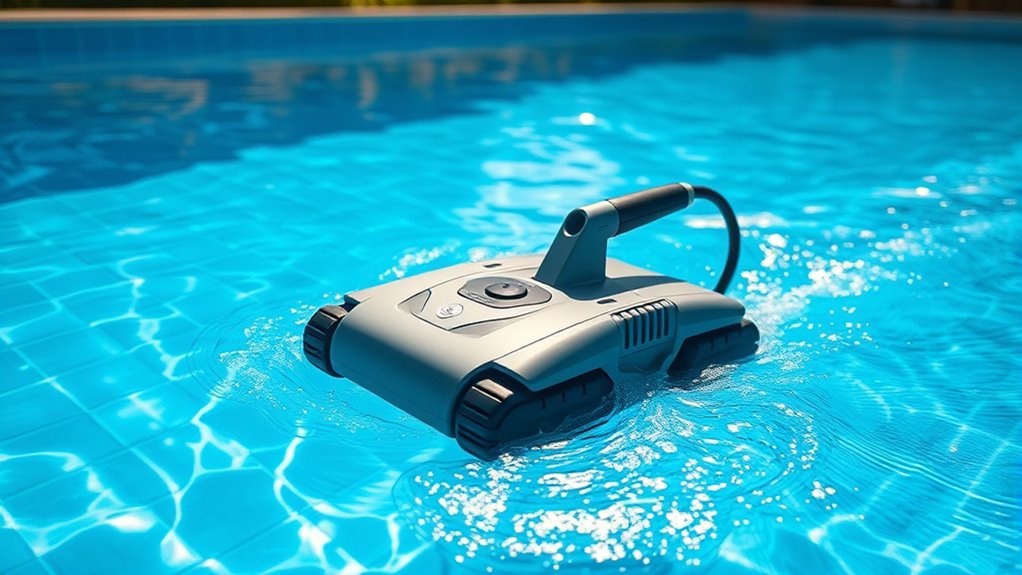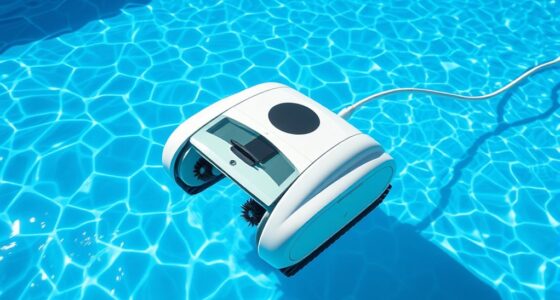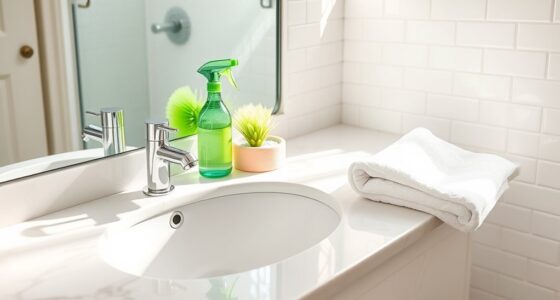If your pool is small to medium-sized with a straightforward shape, smooth surfaces, and minimal debris, a suction pool cleaner is a smart choice. It’s affordable, energy-efficient, easy to set up, and requires less maintenance. However, if your pool has complex features or heavy debris, robotic or pressure-side cleaners might suit better. Keep going to discover more about when a suction cleaner works best and how to get the most out of it.
Key Takeaways
- Ideal for small to medium pools with simple shapes and smooth surfaces, where navigation and coverage are manageable.
- Cost-effective choice for basic maintenance, especially if the pool’s plumbing and pump are compatible with suction cleaners.
- Suitable for pools with minimal debris and straightforward geometry, as they struggle with complex features and tight corners.
- Easy to set up and operate, making them ideal for homeowners seeking low-maintenance, automated cleaning solutions.
- Less effective for large debris or intricate pool designs, where robotic or pressure-side cleaners may provide superior cleaning.
Suitable Pool Sizes and Shapes for Suction Cleaners
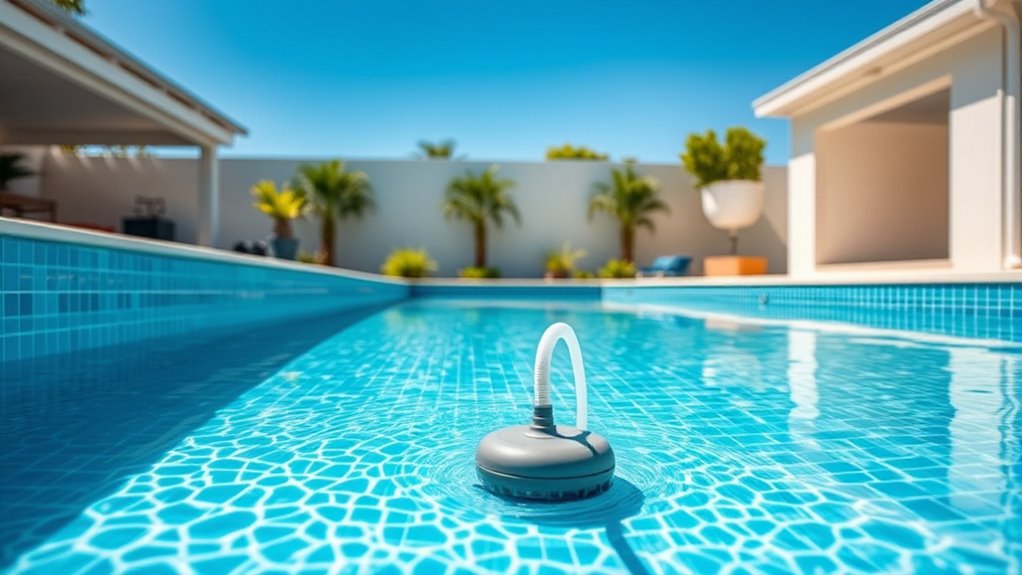
Suction pool cleaners work best with pools that are of moderate size and simple shape. If your pool isn’t too large, these cleaners can efficiently cover the surface without missing spots. They excel in pools with straightforward designs because their movement is easier to control within a simple shape like a rectangle or oval. Complex pool shapes, such as freeform or irregular designs, might challenge a suction cleaner’s ability to reach every corner effectively. Also, larger pools may take longer to clean thoroughly, which can reduce efficiency. For peak performance, choose a suction cleaner suited to your pool size—small to medium pools are ideal—and confirm the pool shape isn’t overly complicated. This way, you’ll get the best cleaning results with minimal hassle. Additionally, understanding bedroom design principles can help you create a relaxing environment that complements your pool area and enhances overall outdoor living space. Proper planning of pool maintenance routines can further ensure your pool remains clean and inviting throughout the season.
Pool Surfaces and Debris Types Best Managed by Suction Models

Because of their design, suction pool cleaners excel at managing smooth, non-porous surfaces like fiberglass, vinyl, and polished concrete, ensuring debris is lifted effectively without getting stuck. They’re especially good at removing dirt, leaves, and small debris, making them ideal for regular maintenance. When it comes to algae removal, suction models can be effective if combined with proper chemical treatment, as they can vacuum algae-covered areas without spreading spores. These cleaners also work well on surfaces that are chemically compatible with their materials, reducing the risk of damage. Additionally, their ability to operate efficiently relies on the surface porosity, which influences debris trapping and cleaning effectiveness. Their filtration systems, such as HEPA filters, help capture fine particles, improving overall cleaning. Proper maintenance of the filter cartridges is essential for consistent performance and longevity of the cleaner. However, porous surfaces or textured finishes may pose challenges, as debris can hide or get trapped. It’s important to consider the type of debris typically found in your pool to select the best cleaning method. Overall, suction cleaners are best suited for surfaces that promote smooth operation and straightforward debris removal.
Cost-Effectiveness and Maintenance Considerations

When evaluating suction pool cleaners, considering their cost-effectiveness and maintenance needs is essential for making a smart investment. You should examine pricing strategies across different brands, as some offer more affordable options with reliable features, while others may seem pricier but include longer-lasting parts or better warranties. Brand reputation plays a significant role in your decision; trusted brands often provide easier access to replacement parts and clearer maintenance guidance, reducing long-term costs. Keep in mind that lower upfront prices might lead to higher maintenance expenses down the line if the cleaner isn’t durable. Additionally, understanding potential security vulnerabilities in new payment technologies can help you choose more reliable and secure options. Incorporating industry trends into your decision-making process can also provide insights into the latest innovations that improve durability and efficiency. Recognizing product lifecycle costs can further assist in selecting a model that offers the best value over time. Staying informed about regulatory changes related to pool equipment can help you ensure compliance and avoid future expenses. Considering maintenance frequency and ease of repair can significantly impact your overall costs and convenience. By balancing initial costs with anticipated maintenance needs and choosing reputable brands, you’ll ensure your suction pool cleaner remains a cost-effective and low-maintenance solution over time.
Compatibility With Pool Pump Systems and Plumbing
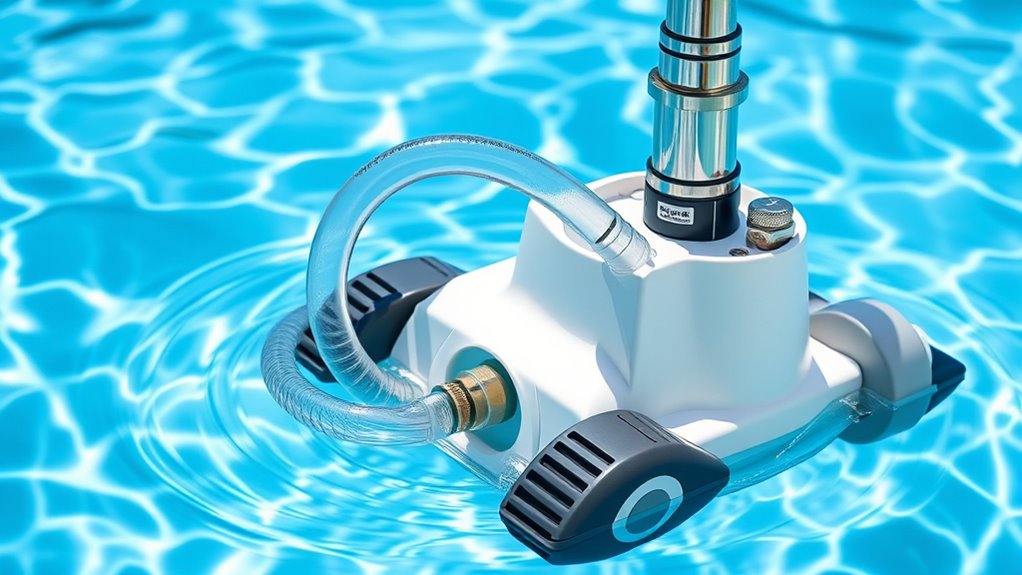
Ensuring your pool cleaner works seamlessly with your existing pump system and plumbing setup is key to maximizing its efficiency and avoiding costly issues. Proper plumbing integration and pool pump compatibility are essential for optimal performance. Before purchasing, check that your pump’s flow rate matches the cleaner’s requirements. Consider the following:
Ensure your pool cleaner’s compatibility with your pump system for optimal, trouble-free operation.
- Compatibility with your pool pump’s size and power
- Whether the cleaner connects easily to existing skimmer or dedicated suction port
- The presence of necessary adapters or fittings
- The overall plumbing layout for smooth operation
- Awareness of AI-driven innovations that may influence future pool cleaning technologies
- Confirming that your plumbing system incorporates appropriate fittings to ensure secure and effective connections. Additionally, verifying system compatibility helps prevent potential malfunctions and ensures the longevity of your equipment.
If your plumbing system isn’t compatible, you risk reduced cleaning efficiency or damage. Confirming these aspects ensures your suction pool cleaner functions effectively without putting strain on your system. Proper pool system compatibility is vital for consistent, trouble-free operation.
Ease of Use and Setup for Homeowners

Setting up a suction pool cleaner is straightforward, even for homeowners with minimal experience. You simply connect it to your skimmer or dedicated suction line, and it’s ready to go. Manual operation is minimal, usually involving placing the cleaner in the water and turning on your pump. Adjusting cleaning frequency depends on pool usage and debris levels, but once set, it runs automatically. The setup process is quick, and maintenance is simple. Automation technologies can make this process even more seamless by allowing remote control and scheduling. Additionally, some models feature hydrocolloid-like components that enhance debris retention and improve overall cleaning efficiency. These features contribute to the ease of maintenance, making it easier for homeowners to keep their pools clean without much effort. For added convenience, many models are compatible with smart pool systems, allowing for more integrated control. Here’s a quick comparison:
| Feature | Details |
|---|---|
| Manual operation | Usually just placement; minimal intervention needed |
| Cleaning frequency | Adjustable based on debris; typically weekly or biweekly |
This ease of use makes suction cleaners ideal for homeowners seeking simple, reliable pool maintenance. For those concerned about efficiency, selecting a vetted model ensures optimal performance with minimal hassle.
Energy Efficiency and Operating Costs
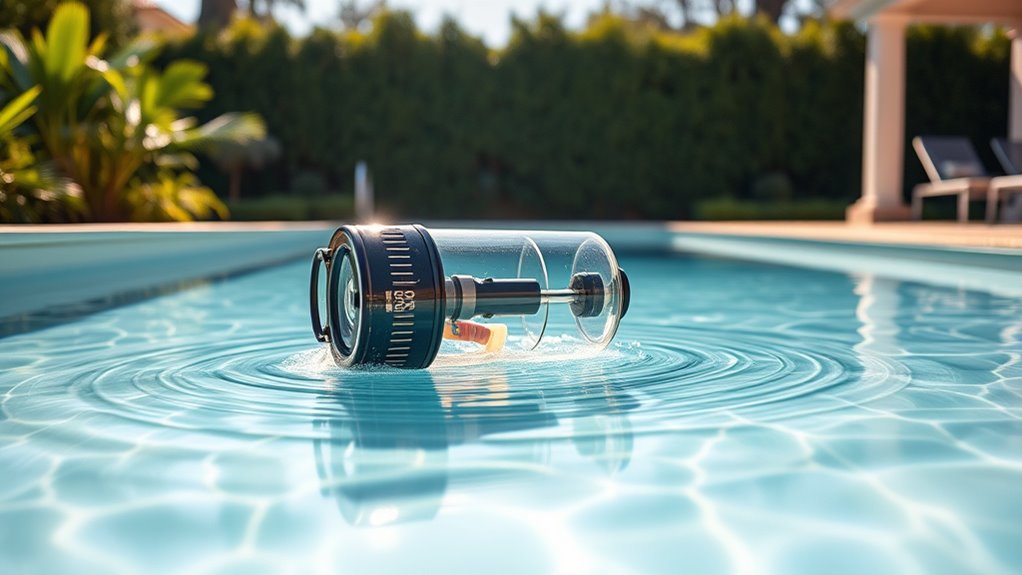
Energy efficiency is a key factor to contemplate when choosing a suction pool cleaner, as it directly impacts your operating costs. Suction cleaners often consume less power, helping you save on electricity bills. Some models incorporate solar energy options, reducing energy consumption further and promoting eco-friendliness. Additionally, pay attention to noise levels; quieter models won’t disturb your household or neighbors during operation. Consider these points:
Choosing an energy-efficient suction pool cleaner reduces costs and minimizes noise while promoting eco-friendliness.
- Low power consumption reduces ongoing costs
- Solar energy integration minimizes electricity use
- Quiet operation enhances user experience
- Fewer moving parts mean less maintenance
Choosing a model with Kia Tuning features can also improve the overall efficiency of your pool cleaning system by optimizing performance and reducing energy waste. Understanding investment diversification can help you balance upfront costs with long-term savings in your pool maintenance setup. Opting for an energy-efficient suction cleaner can notably lower your long-term expenses while keeping your pool sparkling clean. This makes it a practical choice, especially if you’re mindful of energy usage and noise considerations. Additionally, selecting a model with advanced filtration systems can enhance cleaning efficiency and reduce the need for frequent maintenance. Incorporating modern performance upgrades can further extend the lifespan of your cleaner and improve its effectiveness over time.
Limitations and Situations Where Suction Cleaners May Fall Short

Suction pool cleaners have limitations you should consider before choosing one. They often struggle with complex pool shapes and may miss spots due to limited navigation. Additionally, they can be less effective at removing large debris or things that get stuck. For instance, they may not be suitable for certain types of pool decorations or intricate features that require more advanced cleaning methods. Moreover, their performance can be affected by the size and layout of the pool, which influences their ability to clean thoroughly.
Limited Navigation Capabilities
While suction pool cleaners are effective for general cleaning, their limited wayfinding capabilities can cause issues in complex pool layouts. Navigation limitations mean they often struggle to cover all areas efficiently. You might notice the cleaner missing spots or getting stuck on obstacle challenges. These limitations can result in longer cleaning times and incomplete debris removal. To avoid this, consider these factors:
- Inability to adapt to intricate shapes
- Difficulty navigating around steps or ledges
- Trouble reaching tight corners
- Getting caught on drains or return jets
Because of these obstacle challenges, suction cleaners may fall short in pools with complex designs. They’re best suited for simple, open layouts where their navigation isn’t hindered. Recognizing these limitations helps you decide when a suction cleaner suits your pool.
Difficulties With Complex Pool Shapes
Complex pool shapes pose significant challenges for suction cleaners, as their limited navigation systems often can’t handle intricate designs. Pool shape challenges become evident when the pool features narrow corners, irregular edges, or multiple levels. These navigation limitations prevent the cleaner from effectively reaching all areas, leaving some spots uncleaned. Suction cleaners rely on simple movement patterns, which work well in straightforward pools but struggle with complex layouts. If your pool has a freeform or highly detailed design, a suction cleaner might miss sections or get stuck. It’s essential to assess your pool’s shape before choosing this type of cleaner. Otherwise, you risk incomplete cleaning and frustration, as the cleaner’s navigation limitations become more apparent in complex pool environments.
Reduced Effectiveness on Debris
Have you noticed that suction pool cleaners sometimes struggle to pick up certain types of debris? Their effectiveness can be limited, especially with larger or heavier debris. Since they rely on suction, they may miss items like leaves, sticks, or small pebbles. Manual operation can sometimes be necessary to assist with debris collection. You might find yourself having to clear out debris manually or reposition the cleaner to improve performance. Additionally, suction cleaners often fall short when dealing with:
- Large leaves or sticks that block the intake
- Fine debris like sand or dirt that can clog filters
- Heavy debris that resists suction power
- Floating debris that escapes beneath the cleaner
In these situations, suction cleaners may not be the best choice, requiring extra effort for thorough cleaning.
Comparing Suction Cleaners to Robotic and Pressure-Side Alternatives
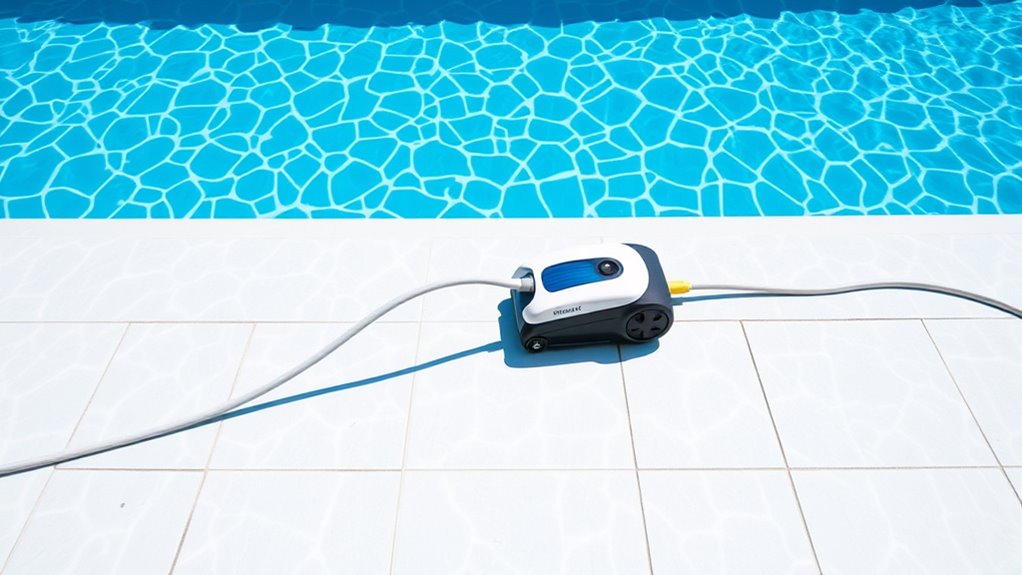
Suction pool cleaners offer a straightforward and affordable way to keep your pool clean, but they’re just one option among robotic and pressure-side models. Your choice depends on factors like pool size and debris removal needs. Robotic cleaners excel at thorough cleaning, especially for larger pools, thanks to their dedicated motors and programming. Pressure-side cleaners use the pool’s pump to remove debris efficiently, ideal for bigger debris or heavy buildup. Suction cleaners are simple and cost-effective but may struggle with large debris or extensive pool sizes. Here’s a quick comparison:
| Feature | Suction Cleaner | Robotic Cleaner | Pressure-Side Cleaner |
|---|---|---|---|
| Pool Size | Small to medium | Large | Large |
| Debris Removal | Moderate | Excellent | Good |
| Maintenance | Low | Moderate | Moderate |
Choose based on your pool’s specific needs.
Frequently Asked Questions
How Long Does It Typically Take for a Suction Pool Cleaner to Clean a Standard Pool?
Cleaning speed varies based on your pool size and the cleaner’s efficiency. Typically, a suction pool cleaner takes about 2 to 4 hours to thoroughly clean a standard pool, which is around 20,000 gallons. Larger pools may take longer, while smaller ones finish quicker. To guarantee ideal cleaning, check the cleaner’s specifications and adjust your expectations based on your pool’s size and the cleaner’s performance.
Can Suction Cleaners Effectively Remove Algae and Stubborn Debris?
Imagine your pool gets covered in algae and stubborn debris. A suction pool cleaner can help with algae removal and debris elimination, but it may struggle with heavy algae buildup or large debris. For light to moderate algae, it’s effective; however, for stubborn algae or large debris, you might need a specialized cleaner. Regular maintenance and proper filter cleaning improve its effectiveness in keeping your pool pristine.
Are Suction Pool Cleaners Suitable for Above-Ground Pools?
If you have above-ground pools, suction pool cleaners are a great choice thanks to their portability and DIY installation. They easily move around above-ground pools, cleaning efficiently without complex setup. You’ll appreciate how simple it is to connect them to your pool’s skimmer or dedicated suction line, making maintenance straightforward. Suction cleaners work well for above-ground pools, giving you a hassle-free, cost-effective way to keep your pool clean.
What Safety Precautions Should Be Taken When Installing a Suction Cleaner?
When installing a suction pool cleaner, focus on installation safety by carefully following manufacturer instructions. Verify all electrical considerations are addressed—keep unplugged when connecting hoses and avoid contact with water during setup. Check for secure fittings and avoid creating tripping hazards. Always turn off power sources before starting installation, and consider consulting a professional if you’re unsure. Proper safety measures prevent accidents and ensure your cleaner functions effectively.
How Often Should the Filters or Bags Be Replaced or Cleaned?
Oh, the thrill of filter maintenance—so glamorous, yet so necessary. You should clean your filters or bags at least once a week, especially after heavy use or storms. Replace them when they show signs of wear or clogging, usually every few months. Regular cleaning frequency keeps your suction pool cleaner running efficiently, preventing debris build-up and ensuring sparkling water. Skip this, and your pool’s beauty might just float away!
Conclusion
If you opt for a suction pool cleaner, you’ll enjoy a cost-effective, easy-to-maintain option that handles most common debris and pool shapes. Did you know that suction cleaners typically use 30% less energy than robotic models? While they may not tackle large debris or complex pools as well, their simplicity and affordability make them a smart choice for many homeowners. Consider your pool size and needs to decide if a suction cleaner is your best fit.

